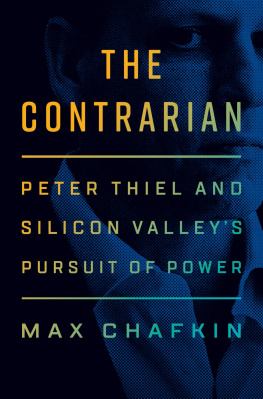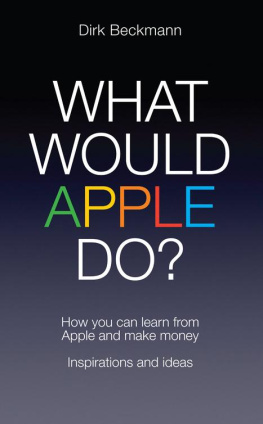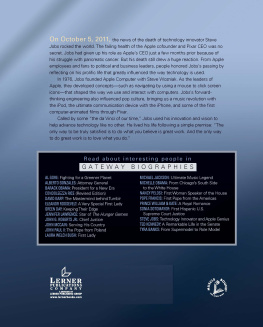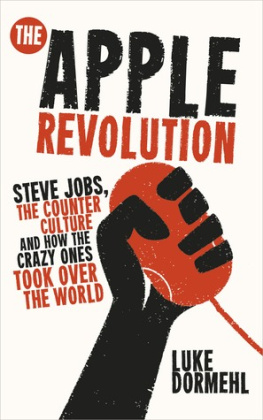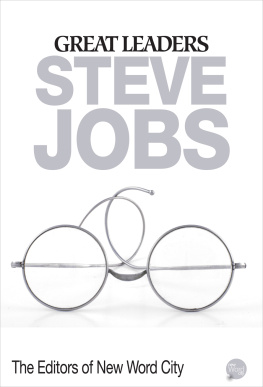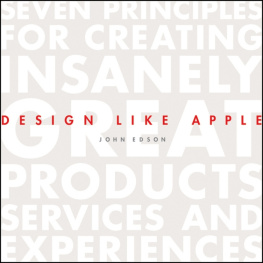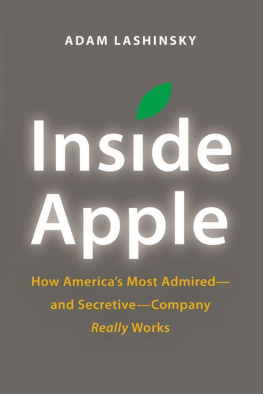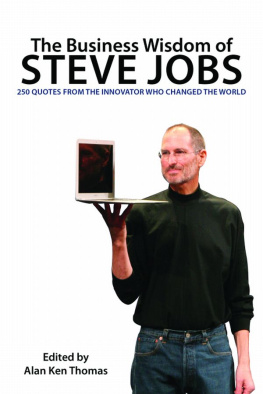Design Crazy
Good Looks, Hot Tempers, and True Genius at Apple
By Max Chafkin
Additional reporting by
Austin Carr, Skylar Bergl, and Mark Wilson
A FAST COMPANY / BYLINER ORIGINAL
Copyright 2013 by Max Chafkin and Fast Company
All rights reserved
Cover image Bernard Bisson/Sygma/Corbis
ISBN: 978-1-61452-086-3
Byliner Inc.
San Francisco, California
www.byliner.com
For press inquiries, please contact
10 9 8 7 6 5 4 3 2 1
Table of Contents
Introduction
This is our signature, Apples gauzy television ads proclaim, referring to the familiar words that the company stamps on the undersides of its products: DESIGNED BY APPLE IN CALIFORNIA. The ads fall in the grand Apple traditionbeginning with the 1984 Super Bowl spotof seeming to say a great deal while revealing little. Apple is one of the most intensely competitive, pathologically secretive organizations in history. If there is one thing that CEO Tim Cook doesnt want people to know, its what is behind his companys signature. As a result, most efforts to explain design at Apple end up reducing a complex thirty-seven-year history to bromides about simplicity, quality, and perfectionas if those were ambitions unique to Apple alone.
So the editors of Fast Company asked me and my co-writersAustin Carr, Skylar Bergl, and Mark Wilsonto try to remedy that. It wasnt easy: Precious few designers have left Sir Jonathan Ives industrial design group since he took over in 1996: Two quit, three died. (We talked to the two who quit, among dozens of other longtime Apple veterans.) What we found is that the greatest business story of the past two decadeshow Apple used design to rise from near bankruptcy to become the most valuable company in the world, while bringing sophisticated computers to hundreds of millions of peopleis deeply misunderstood.
Outsiders have tended to assume that because cofounder and longtime CEO Steve Jobs was a champion of products in which hardware and software work together seamlessly, Apple itself was a paragon of cross-collaboration. In fact, the opposite was often true. And though Jobs was without a doubt the single most important figure in the companys history, the story of the Apple founders exile and restoration has obscured the fact that much of the critical design work that led to Apples resurgence started while Jobs was running Pixar and NeXT. Iveof whom Jobs once said, He has more operational power than anyone else at Apple except mejoined the company in 1992, and hed already taken over the companys vaunted industrial design group when Jobs returned in 1997. That many people believe that Jobs plucked Ive out of obscurity probably says more about Jobss own capacity for mythmaking than it does about the company he built.
Ives power has continued to grow since Jobss death in October 2011. Last year, following the ouster of Jobss longtime software guru Scott Forstall, Ive expanded his domain to include software as well as industrial design. This past June, at the companys Worldwide Developers Conference, Cook unveiled Ives first software creation: a new, minimalistic version of the iPhone operating system, iOS 7. The applause was deafening, as usual. Technology and design blogs cooed, and mainstream media outlets felt compelled to linger on arcane discussions of user interface design, explaining how Apple is moving away from skeuomorphism (the use of realistic, three-dimensional icons) toward flat design (a more impressionistic, two-dimensional style).
Ive didnt appear onstage, choosing instead to watch the proceedings with the companys board of directors in the front row, directing a courtly gaze at his colleagues Phil Schiller and Craig Federighi as the marketer and software engineer, respectively, showed off his work. This might be surprising, but then, Ive prefers to appear publicly in prerecorded promotional videos, playing his part as Apples English gentleman-designer. That character is more than willing to expound beautifully on Apples heritage as a company concerned with making technology accessible to regular people, but in the few instances Ive has spoken publicly about his lifes work, hes refused to divulge such basic information as the size of his industrial design team, or how Apples product development process actually works.
Historically, Ives shyness might have been a political move: he was an up-and-comer at a company ruled by a brilliant, dictatorial CEO with a penchant for picking fights with rivals and claiming their best ideas for himself. But whatever the intent, the effect of Ives celebrity has given his work an undeniable mystique. The iPhone was a revolutionary consumer product, but then, so was the Toyota Prius. No one calls it the Jesus Car.
Neither Ive, nor anyone else at Apple, was willing to speak on the record for this story, preferring to let the work speak for itselfand to preserve the companys fastidiously cultivated mythology. As a result, this is a story different from any other youve ever read about Apple. It is an oral history of Apples design, a decoding of the signature as told by the people who helped create it.
1.
A Bicycle for the Mind
1980
TRIP HAWKINS marketing and product manager, Apple Lisa group (later founder of Electronic Arts)
One day, Steve [Jobs] comes in with a copy of Scientific American. Steve loved Scientific American. He shows us this article about the energy efficiency of animals. It says that, if you look at which animal is the most efficient, in terms of miles per kilocalorie, its the condor. And humans are way, way down the listyou know, with the rank-and-file animals. But, Steve says, a human being on a bicycle is twice as efficient as the condor. That was the kind of storytelling Steve could do to inspire people. That turned into a full-page ad in the Wall Street Journal on the day the company went public.
DAVE MORIN, marketing manager, 20042006 (now CEO of Path, a mobile social-networking app)
Apple is rooted in the depth of its history. The metaphorthe computer as a bicycle for the mindhave you heard this? That was very much a part of the way we talked about computers even when I was at Apple.
Jobss inspirationthat computers could enhance human potential the same way that bicycles transformed our energy efficiencyseems obvious in retrospect, but the idea was radical at the time, even within Apple itself. In the early 1980s, the company was suffering through acute growing pains, beset by warring factions and destabilized by Jobss battle with the board of directors, whod stripped him of his operating role. Worse, the products were underwhelming. The Apple III, initially conceived as a successor to the wildly successful Apple II, was hamstrung by technical problems, and the Lisa, which featured a groundbreaking graphical user interface based on work done at the research lab Xerox PARC, was prohibitively expensive, at roughly $10,000. Within all that chaos, Jobs took over a small skunkworks project to develop a low-cost computer for the masses. He code-named the project Bicycle.
ANDY HERTZFELD, lead software developer, Macintosh group (later at Google, where he helped design Google+)
When I told Steve I needed a day or two to finish up what I was doing before moving over to the Mac building, he unplugged the Apple II I was working on and carried it away with him. I had no choice but to follow. The Macintosh had been an under-resourced research project, a prototype with no clear path to shipping. Steve saw it had a chance to be the future of the personal computer industry.


